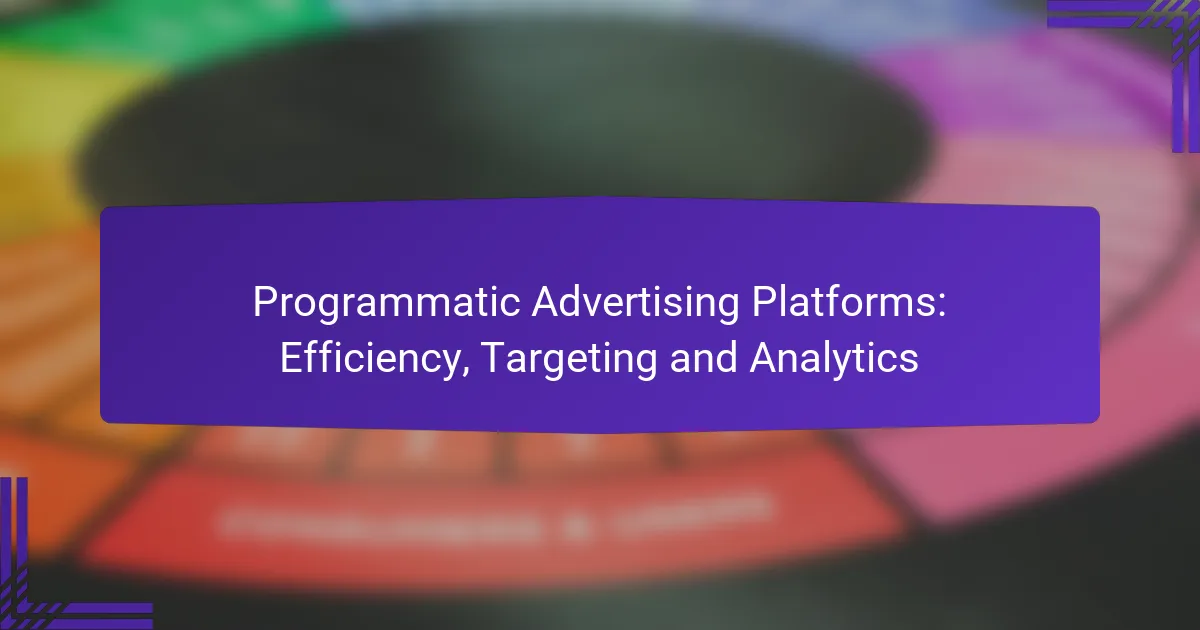Programmatic advertising platforms revolutionize the advertising landscape by automating the ad buying process, which enhances efficiency and reduces costs. With advanced targeting capabilities and real-time analytics, these platforms enable marketers to reach specific audiences effectively and optimize their campaigns based on actionable insights. This focus on data-driven strategies allows for improved ad relevance and maximized returns on investment.

How do programmatic advertising platforms enhance efficiency in Canada?
Programmatic advertising platforms improve efficiency in Canada by automating the ad buying process, enabling precise targeting, and providing real-time analytics. This leads to reduced costs and optimized ad spend, allowing marketers to focus on strategy rather than manual tasks.
Automated ad buying processes
Automated ad buying processes streamline the way advertisers purchase ad space. Instead of negotiating directly with publishers, programmatic platforms use algorithms to buy inventory in real-time, significantly speeding up the process. This automation reduces human error and allows for more consistent campaign execution.
For example, advertisers can set parameters such as budget limits and target demographics, and the system will automatically place bids on relevant ad spaces. This not only saves time but also ensures that ads reach the intended audience effectively.
Real-time bidding advantages
Real-time bidding (RTB) allows advertisers to bid on ad impressions as they become available, ensuring that they only pay for the most relevant placements. This competitive bidding environment can lead to lower costs per impression compared to traditional methods. Advertisers can adjust their bids based on performance metrics, optimizing their spending in real-time.
In Canada, this means that advertisers can take advantage of local trends and audience behavior, making their campaigns more responsive and effective. The flexibility of RTB helps in maximizing return on investment (ROI) by targeting users when they are most likely to engage.
Streamlined campaign management
Programmatic platforms offer tools for streamlined campaign management, allowing advertisers to monitor and adjust campaigns from a single dashboard. This centralization simplifies the process of tracking performance metrics, such as click-through rates and conversions, enabling quick decision-making.
Additionally, many platforms provide analytics that highlight which ads are performing best, allowing marketers to allocate budgets more effectively. By regularly reviewing these insights, advertisers can refine their strategies and improve overall campaign outcomes.

What targeting capabilities do programmatic advertising platforms offer?
Programmatic advertising platforms provide advanced targeting capabilities that enhance ad relevance and effectiveness. These capabilities include audience segmentation, geolocation targeting, and behavioral strategies, allowing advertisers to reach specific demographics and optimize their campaigns based on user data.
Audience segmentation techniques
Audience segmentation techniques enable advertisers to categorize potential customers into distinct groups based on shared characteristics. Common methods include demographic segmentation (age, gender, income), psychographic segmentation (interests, values), and firmographic segmentation (industry, company size). This targeted approach helps in crafting personalized messages that resonate with each segment.
For effective audience segmentation, consider utilizing data analytics tools that can process large datasets to identify trends and patterns. Additionally, regularly updating your segments based on changing consumer behaviors can enhance campaign performance.
Geolocation targeting options
Geolocation targeting allows advertisers to deliver ads based on a user’s physical location, which can significantly improve relevance. Options include targeting by country, region, city, or even specific areas within a city. This is particularly useful for local businesses aiming to attract nearby customers.
When implementing geolocation targeting, consider using geofencing techniques to trigger ads when users enter a defined area. This can lead to higher engagement rates, especially for time-sensitive promotions or events.
Behavioral targeting strategies
Behavioral targeting strategies focus on users’ past online behaviors, such as websites visited, content consumed, and interactions with previous ads. By analyzing this data, advertisers can predict future behavior and tailor ads accordingly. This method increases the likelihood of conversion by reaching users with relevant offers at the right time.
To effectively implement behavioral targeting, utilize tracking technologies like cookies and pixels to gather data. However, be mindful of privacy regulations, such as GDPR in Europe, which require transparency and consent from users regarding their data usage.

How do analytics improve programmatic advertising outcomes?
Analytics enhance programmatic advertising outcomes by providing insights into campaign performance, audience behavior, and overall effectiveness. By leveraging data, advertisers can optimize their strategies, ensuring better targeting and higher returns on investment.
Performance tracking metrics
Performance tracking metrics are essential for evaluating the success of programmatic advertising campaigns. Key metrics include click-through rates (CTR), conversion rates, and cost per acquisition (CPA). Monitoring these metrics allows advertisers to identify which ads perform well and which need adjustment.
For example, a CTR of around 2-5% is often considered effective, while a CPA should align with the value of the conversions generated. Regularly reviewing these metrics helps in making informed decisions about budget allocation and creative strategies.
Attribution models for ROI
Attribution models help determine how different touchpoints contribute to conversions, allowing advertisers to assess the return on investment (ROI) of their campaigns. Common models include first-click, last-click, and multi-touch attribution, each providing unique insights into customer journeys.
For instance, a multi-touch model might reveal that several ads played a role in a conversion, prompting advertisers to invest more in channels that are effective throughout the customer journey. Understanding these models can lead to more strategic budget distribution across various platforms.
Data-driven decision making
Data-driven decision making involves using analytics to guide advertising strategies, ensuring that choices are based on empirical evidence rather than intuition. This approach allows advertisers to refine targeting, optimize ad placements, and enhance creative content based on real-time data.
For effective data-driven strategies, advertisers should regularly analyze performance data and adjust campaigns accordingly. Utilizing A/B testing can also provide insights into which variations of ads resonate best with the target audience, leading to improved outcomes over time.

What are the key criteria for selecting a programmatic advertising platform?
When selecting a programmatic advertising platform, consider integration with existing tools, scalability, and cost structure. These criteria ensure that the platform meets your operational needs and budget while providing effective advertising solutions.
Integration with existing tools
Effective integration with your current marketing tools is crucial for a seamless workflow. Look for platforms that can easily connect with your Customer Relationship Management (CRM) systems, analytics tools, and content management systems. This connectivity allows for better data sharing and campaign management.
For example, if your team uses Google Analytics, a programmatic platform that offers direct integration can help you track campaign performance in real-time, making adjustments more efficient. Ensure that the platform supports the APIs and data formats your tools utilize.
Scalability of the platform
Scalability is essential for adapting to changing business needs and growing advertising demands. A good programmatic platform should accommodate increasing volumes of ad spend and traffic without compromising performance. This flexibility allows you to expand your campaigns as your business grows.
Consider platforms that offer tiered service levels or customizable features that can evolve with your requirements. For instance, if you start with a small budget, ensure the platform can handle larger campaigns as your budget increases, ideally without requiring a complete overhaul.
Cost structure and pricing models
Understanding the cost structure and pricing models of a programmatic advertising platform is vital for budgeting. Common pricing models include cost-per-thousand impressions (CPM), cost-per-click (CPC), and cost-per-acquisition (CPA). Each model has its advantages depending on your campaign goals.
Evaluate whether the platform charges a flat fee, a percentage of ad spend, or a combination of both. For instance, a CPM model may be more cost-effective for brand awareness campaigns, while a CPA model might be better suited for direct response campaigns. Always consider hidden fees that could impact your overall budget.

Which programmatic advertising platforms are popular in Canada?
In Canada, popular programmatic advertising platforms include Google Marketing Platform and Adobe Advertising Cloud. These platforms are favored for their robust targeting capabilities, efficiency in ad buying, and comprehensive analytics features.
Google Marketing Platform
Google Marketing Platform integrates various tools for advertisers, enabling efficient ad management across multiple channels. It allows users to leverage data for precise targeting, optimizing campaigns based on real-time performance metrics.
Key features include Display & Video 360 for programmatic buying and Google Analytics for tracking user engagement. Advertisers can easily set budgets and adjust bids, ensuring they reach their target audience effectively.
When using Google Marketing Platform, ensure you regularly analyze campaign data to refine targeting strategies. Avoid common pitfalls like neglecting A/B testing, which can significantly enhance ad performance.
Adobe Advertising Cloud
Adobe Advertising Cloud offers a comprehensive solution for managing digital advertising across various formats and channels. It combines data-driven insights with creative tools, allowing advertisers to craft personalized campaigns that resonate with their audience.
This platform supports programmatic buying and provides advanced analytics to measure campaign success. Users can integrate their existing data sources to enhance targeting and improve ROI.
To maximize the benefits of Adobe Advertising Cloud, focus on utilizing its creative capabilities alongside data analytics. Don’t overlook the importance of continuous optimization based on performance insights to ensure effective ad spend.
